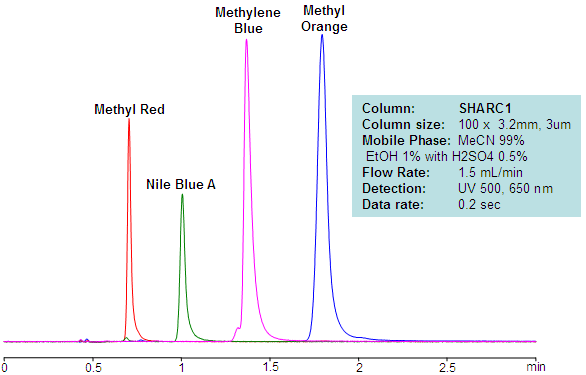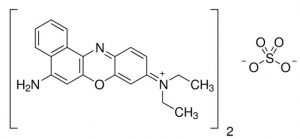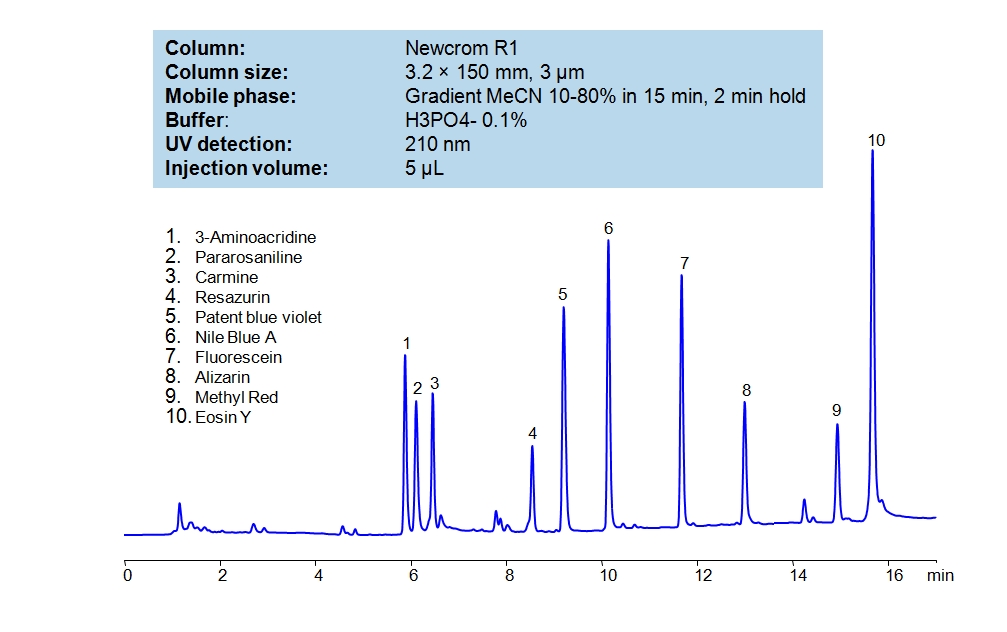| CAS Number | 3625-57-8 |
|---|---|
| Molecular Formula | C40H40N6O6S |
| Molecular Weight | 732.856 |
| InChI Key | QIRDPEPUXNCOLD-UHFFFAOYSA-N |
| Synonyms |
|
Applications:
HPLC Method for Analysis of Dyes
March 1, 2018
Alizarin a red pigment that comes as a red powder with a slight orange tint. When dissolved it appears bright red with a slight pink undertone. Alizarin is also known as Mordant Red 11 or Turkey Red. Eosin Y is a pigment that comes as an orange powder that when dissolved in water turns bright orange. Eosin is a fluorescent staining agent. It is used to stain red blood cells, proteins on cytoplasm, collage, and muscle fibers. It is also fluorescence. Fluorescein is a dye that comes in a dark orange powder and is used as a tracer and an indicator. As it says in the name, it is also Fluorescent, obtaining a green-yellow color when under black light. Methyl red an indicator that turns red in acidic solutions (below 4.4 pH), is a shade of orange between 4.5 and 6.1 pH, and turns bright yellow in basic solutions (above pH 6.2). Nile blue, also known as Nile blue A, is used as a stain used in biology and histology as well as a pH indicator. In pH below 7 it becomes lighter shades of glue, and at pH 0 becomes almost completely translucent. At pH of seven it has a dark blue shade, while at pH higher than that it starts becoming more red. Pararosaniline Hydrochloride, also known as Basic Red 9, or C.I. 42500. It is a a magenta solid that is used as a dye. Patent Blue Violet, also known as Patent Blue, is a deep blue pigment that is often used to dye clothes. Resazurin is a blue dye as well as a pH indicator. At pH 3.8 or lower, it is bright orange, but the higher the pH the more blue it becomes, the color stops changing at the pH of 6.5 where it becomes indigo. Newcrom R1, a column that takes advantage of the newest technologies, does not contain embedded acidic nor basic ionizable groups and can retain dyes. The method is UV compatible and can be used as a general approach for analyzing similar compounds.
Application Column
Newcrom R1
The Newcrom columns are a family of reverse-phase-based columns. Newcrom A, AH, B, and BH are all mixed-mode columns with either positive or negative ion-pairing groups attached to either short (25 Å) or long (100 Å) ligand chains. Newcrom R1 is a special reverse-phase column with low silanol activity.
Select optionsAlizarin
Carmine
Eosin Y
Fluorescein
Fluorescein
Methyl Red
Nile Blue A
Pararosaniline Hydrochloride
Patent Blue Violet (Patent Blue)
Resazurin

HPLC Dye Separation on SHARC1 Column
July 10, 2013

| Column | Sharc 1, 3.2×100 mm, 3 µm, 100A |
| Mobile Phase | MeCN/EtOH – 99/1% |
| Buffer | H2SO4 – 0.5% |
| Flow Rate | 1.5 ml/min |
| Detection | UV, 500, 650 nm |
| Class of Compounds |
Dye, Hydrophilic, Ionizable |
| Analyzing Compounds | Methyl Red, Methyl Orange, Methylene Blue, Nile Blue A |
Application Column
SHARC 1
The SHARC™ family of innovative columns represents the first commercially available columns primarily utilizing separation based on hydrogen bonding. SHARC stands for Specific Hydrogen-bond Adsorption Resolution Column. Hydrogen bonding involves an interaction or attraction between a bound hydrogen atom and molecules containing electronegative atoms, such as oxygen, nitrogen, and fluorine.
Select optionsMethyl Red
Methylene Blue
Nile Blue A





